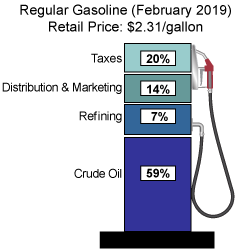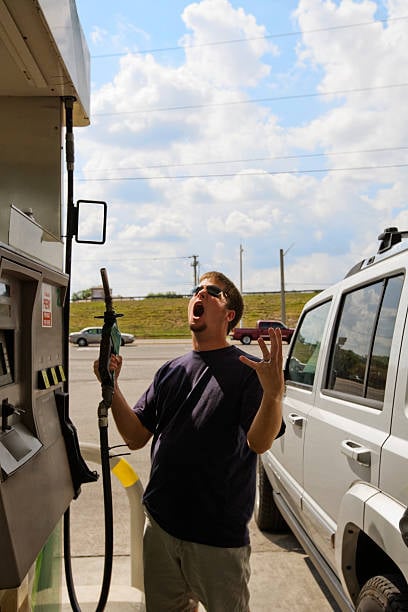
Bob Barker, the legendary American TV game show host of The Price is Right, once said “Why should I pay attention to prices? I can’t win.” While contestants on The Price is Right guessed prices of various goods, they were more or less assured that the retail price of the item in front of them was the same whether it was being sold in California or Florida.
Unfortunately, the same cannot be said for retail fuel prices. Unlike the perfected science behind the formulation of fuel to produce a consistent product, the science behind what consumers will pay when filling up their vehicles is not so perfect.
The price of a gallon of gas is at the mercy of a commodity market and the composition of retail prices for fuel is broken down into four main categories: crude oil, refining, distribution & marketing and taxes.
As of February 2019, the national wholesale price for a gallon of regular unleaded gasoline is $2.31/gallon, according to the U.S. Energy Information Administration. In Houston, the U.S. headquarters of PWM Electronic Price Signs, the price of regular unleaded gasoline is $2.54/gallon — that leaves a 23 cent gross profit margin.
Before you start to think convenience stores are striking it rich by making 23 cents/gallon, it should be noted that 80% of customers pay by credit or debit card, and after credit card processing fees the actual margin is reduced significantly.
The latest State of the Industry (SOI) report by the National Association of Convenience Stores (NACS) shows the average convenience store in the U.S. pays approximately 17 cents per transaction in processing fees — leaving a whopping 6 cents/gallon of profit to the retailer.
Suffice it to say, the retail fuel business is a pennies game that depends heavily on high volume to turn a profit.
Let’s explore some common factors that influence a convenience store’s fuel price:
Components of Retail Gasoline Prices
The main components of the retail price of gasoline are:
- The cost of crude oil
- Refining costs and profits
- Distribution and marketing costs, plus a reasonable profit margin
- Local, state and federal taxes
The cost of crude oil plays the biggest role in the retail price of gasoline. Gasoline characteristics and the price customers see at the pump are influenced heavily by the type of crude oil that is used, including the types of processing technologies available at the refinery where it is produced. Crude oil and its effect on the retail gasoline price vary over time and by geographical region. U.S. crude oil prices are determined by global fundamentals, including supply and demand, seasonality, inventories, financial market considerations and expectations.
Each year, refiners make the switch to summer-grade gasoline ahead  of the May 1st compliance date. Summer-grade gasoline has a lower volatility than winter-grade gasoline to limit evaporative emissions that normally increase with warm weather and cause unhealthy ground-level ozone. Additionally, ingredients such as ethanol and performance additives that are blended into gasoline often impact the retail gasoline prices set by the convenience store. As these refining costs and profits vary by region and season, the price customers pay at the pump will inevitably fluctuate.
of the May 1st compliance date. Summer-grade gasoline has a lower volatility than winter-grade gasoline to limit evaporative emissions that normally increase with warm weather and cause unhealthy ground-level ozone. Additionally, ingredients such as ethanol and performance additives that are blended into gasoline often impact the retail gasoline prices set by the convenience store. As these refining costs and profits vary by region and season, the price customers pay at the pump will inevitably fluctuate.
As gasoline continues to work its way down the channel, distribution, marketing, and retailer costs and profits are all added along the way. The bulk of gasoline is shipped from refineries by pipeline to nearby terminals, where it may be blended with other products to meet local government and market specifications. From there, the gasoline is delivered to convenience stores by a fuel marketer. A fuel marketer is a distribution company that supplies convenience stores with fuel and lubricants. A convenience store’s relationship with their fuel supplier can have a significant impact on the cost to keep their underground tanks full.
Local, State, and Federal government taxes also contribute to the retail price of gasoline. The federal excise tax is 18.30 cents/gallon, and the federal Leaking Underground Storage Tank fee is 1 cent/gallon. As of January 2019, state taxes and fees on gasoline averaged 28.31 cents/gallon. Taxes applied by local and municipal governments along with sales taxes can also have a significant impact on gasoline prices.
Competition
Competition. It's a simple word, yet an all-encompassing and very complex word that covers many angles when it comes to how gasoline prices are determined. It seems so easy to explain, but don't let that trick you — it's incredibly difficult to explain and to adequately understand. Think about it for a moment, what other business advertises their prices on big, bright signs that can be seen from hundreds of feet away? Or even from miles away, if you’re using one of PWM’s gigantic High Rise Signs that offers digits up to 120”!
With over 153,000 convenience stores in the U.S., competition for customers has become an increasingly fierce battle. While price dominates where consumers choose to purchase fuel, other factors such as the quality of fuel, food, and employees also ranked high in a recent study conducted by NACS.
Although fuel demand remained flat in 2018, convenience stores continue to serve nearly half of the U.S. population every day. Increased demand for gasoline in the summer generally results in higher prices, leading convenience stores to compete by maintaining fuel prices that match or are within a few cents of their closest competitors. Most Americans fill-up between 10 am - 3 pm, understanding this customer behavior trend, convenience stores often stabilize their fuel prices during this time period in order to accommodate the influx of customers who are searching for the best priced fuel.
Branded vs Unbranded
Convenience stores have the option to sell fuel under the name of a major oil company or under their own business name.
Stability in the upstream and midstream fuel channels is often unpredictable. In 2017, Hurricane Harvey devastated the Gulf Coast and reduced the U.S. refining capacity by 30%. Customers who were on the move to get out of harm's way and emergency response efforts created a spike in demand when production was struggling to normalize.
During this time convenience stores that were branded had contractual obligations with their fuel supplier which for the most part ensured they would have enough fuel supply to stay open. On the other end, convenience stores that were unbranded were much more susceptible to running out of fuel because they purchase fuel on an as-needed basis.
The debate whether to go branded vs. unbranded is one that has no right answer. For some, the benefit of entering into a contract with an oil company to ensure fuel supply is worth charging their customers slightly more for a gallon of gas. For others, the flexibility of switching fuel suppliers and purchasing product on the spot market fits better with a convenience store’s business strategy, a strategy that often leads to cheaper fuel prices.
Many motorists fail to realize that the price a convenience store pays for gasoline changes daily. Ultimately, all of the fuel that is sold in the U.S. is required to meet requirements that are set by the federal government. This is done to ensure each grade of fuel is consistent and compatible with the internal combustion engines found in the majority of vehicles on the road today.
What is the Right Price to Pay at the Pump?
The costs of doing business by convenience stores vary greatly depending on where the store is located. Those costs include benefits, wages and salaries, lease or rent payments, equipment, insurance, overhead, and state and local fees. Convenience stores that are next to each other can have completely different traffic patterns, rent, and sources of supply — all of which affect their prices.
The reality is the fuel market is complex and shows no signs of simplifying the average customers understanding of prices at the pump. As the market continues to expand and the offerings of retailers continue to vary, there has been one constant when it comes to the price of gasoline: it is the #1 reason that affects where customers choose to fill-up.
At PWM, we know price signs. Our equipment and technology are designed to withstand the elements and save you money. For convenience stores on lots that have a fair amount of space between surrounding businesses, there is no better way to make fuel prices visible to customers, than to go BIG! PWM now offers 32” - 120” digits that are not only giants in size, but also in visibility and durability.
You will thank yourself for going big and you can sleep well at night knowing your customers will never have to guess the price of your fuel.
Read more;
https://www.eia.gov/petroleum/gasdiesel/
https://www.convenience.org/Topics/Fuels/Documents/How-Consumers-React-to-Gas-Prices.pdf






